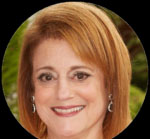By Susan Resnick, OD, FAAO, FSLS

Jan. 8, 2020
Hard-to-fit contact-lens wearers, many of whom have visited other eyecare practices that were unable to help, can be great practice-builders. In addition to the satisfaction of enabling these patients to finally wear contact lenses, you will have gained a pool of highly satisfied, loyal patients willing to pay a premium for your services, and eager to refer others to your office.
What Does “Hard to Fit” Mean?
The term “hard-to-fit”contact lenses has multiple connotations. There are hard-to-fit patients and there are complex contact-lens fittings. The former includes patients who have often been to several ECPs trying to find something that works. Yet they have not achieved total satisfaction with their vision and/or comfort.
The latter encompasses medical contact-lens fitting necessitated by underlying corneal or other ocular pathology, as well as healthy eyes with complex refractive needs. Patients with complex refractive needs can include presbyopic astigmats, high corneal or refractive astigmats and those who are just highly sensitive.
What Kinds of Products Do These Patients Need?
Hard-to-fit patients may be very particular about their visual quality. They will require products with excellent optics; for example a custom soft toric lens to achieve better stability and refinement of prescription or increased optic zone diameter.
Other Articles to Explore
Some presbyopes may be best served with well-fitted custom toric multifocal soft lenses or multifocal RGPS. Scleral lenses typically are a first reach in medically necessary cases. Overcoming comfort problems secondary to dry eye is often achieved with daily disposable contact lenses in addition to proactive therapeutic management.
What is the Cost in Time & Money of Serving Hard-to-Fit CL Patients?
The financial investment in developing a specialty-lens practice serving a wide range of patient needs is dependent upon two main factors: equipment and staffing.
At a minimum, equipment (other than standard exam lane) includes: autorefractor, corneal topographer, radiuscope and meibomian gland diagnostics. There are several instruments that now combine several of these functions, greatly reducing total investment.
We invested roughly $100,000 in equipment over the past two years.
Inventory in specialty lens fitting is not a necessity and, therefore, does not add significant cost. A one-time investment in fitting sets is all it takes. Many lenses are now designed empirically, further reducing initial monetary outlay.
Having well-trained contact-lens technicians is key to reducing chair time and improving patient flow and volume. My rule of thumb is one full-time contact lens technician (equivalent) for each provider in addition to other optometric assistants.
The scheduling time allotted for new complex fits or refits ideally should be the same as for a comprehensive primary care exam.
Having the best technology and staffing is imperative to providing the highest level of patient care and ensuring successful outcomes. Equally important, however, is developing a fee schedule which ensures profitability.
Focus on the Patient Experience
Our approach to serving hard-to-fit patients has been to perfect the patient experience from start to finish. With excellent patient communication and personalized care, patients recognize the value and expertise we are committed to providing. Here are the five key actions we implemented to create a superior patient experience for hard-to-fit patients:
- It’s the doctor who explains the patient’s condition and recommended approach and treatment plan from the exam chair.
- Patients are called to see how they are doing with their newly dispensed lenses within four days of their initial visit.
- A fee range is quoted over the phone at the time the appointment is booked and then further refined and reviewed at the time of the consultation appointment.
- New patients and new dispenses are given priority when scheduling.
- We invested in updated technology, including custom-molded scleral lenses, an updated corneal topographer and additional in-office dry eye therapies.
The Right Patient Experience for Hard-to-Fit Patients Increases Efficiency & Profitability
The implementation of the administrative protocols listed above have greatly improved our efficiency, which indirectly reduces staff time, improves patient flow and avoids costly problems with meeting warranty deadlines.
Additionally, the better patient experience has led to increased referrals, particularly through excellent social media reviews. Gross revenues in this segment increased 3-4 percent due to increased referrals and refits. Profitability increased 2 percent due to the fact that we raised our service fees for this segment.
Educate Yourself & Your Staff to Best Serve These Patients
Excellent professional education for building and growing a contact-lens specialty practice include both national meetings and web-based options. Online resources include: GPLI.org and Sclerallens.org. Meetings with courses devoted to specialty contact-lens practice include: Global Specialty Lens Symposium, American Academy of Optometry and Vision Expo East and West.
We devote three months of intensive training with each new hire, no matter their level of prior experience. Additional training resources include manufacturers representatives in-office workshops for staff, online courses featured on distributors web sites, live courses certified by ABO- NCLE at national meetings and web-based courses available through doctor-alliance groups.
Focus on Continuous Improvement
We continue to add new lens designs to our fitting armamentarium. This increases success rates. More customization is offered by technologies continuing to be launched in both the custom soft lens and scleral lens space. This includes improved designs for presbyopia and scanning technologies for scleral shape. The potential benefit to patients is better vision and improved comfort.
Practice profitability will increase through increased referrals. Our goal is to achieve a minimum of 2-3 percent revenue growth per year in this area of our practice.
 Susan Resnick, OD, FAAO, FSLS, is president of Drs. Farkas, Kassalow, Resnick & Associates in New York City. To contact her: sresnick525@gmail.com
Susan Resnick, OD, FAAO, FSLS, is president of Drs. Farkas, Kassalow, Resnick & Associates in New York City. To contact her: sresnick525@gmail.com

























